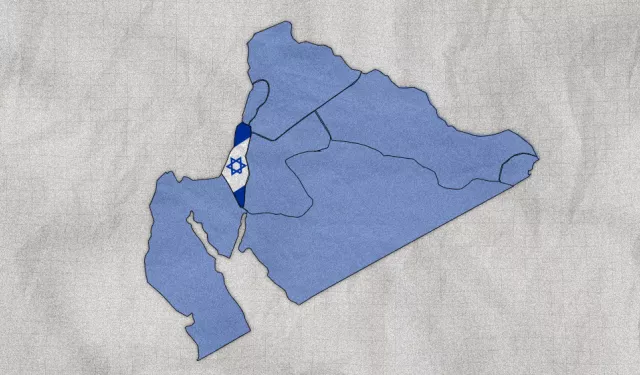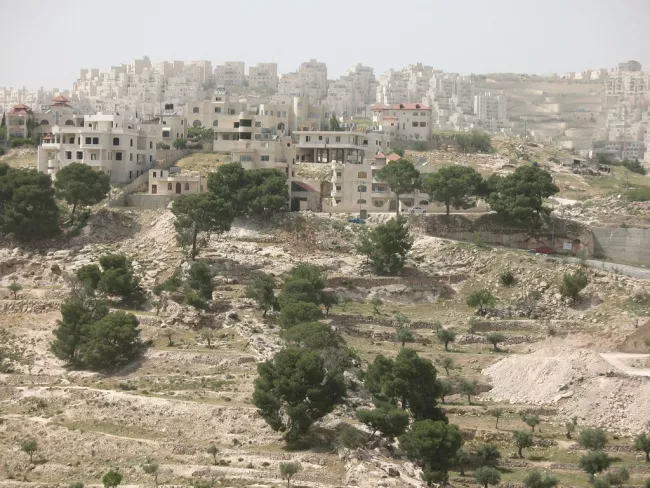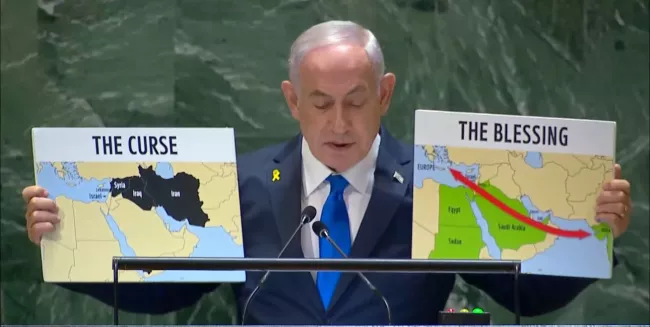
Lebensraum reimagined: The myth of ‘Greater Israel’
Reactions varied to the Israeli PM Benjamin Netanyahu's reference to the dream of a “Greater Israel” during a recent TV interview between alarm, mobilization, and attempts to understand. Not to mention a wave of official condemnations from Arab capitals, Islamic countries, and international organizations.
Netanyahu did not use the term explicitly, nor did he speak of occupying parts of Egypt, Jordan, or Iraq. But it’s hard to see the moment the interviewer presented him with an amulet bearing a map of “Greater Israel” as spontaneous, especially since Netanyahu is still facing legal trouble over “illicit gifts.” The scene took on added irony when the interviewer said the gift was for his wife. Netanyahu accepted it with gratitude, signaling his strong embrace of the vision symbolized by the amulet.
The interview had clearly been carefully edited, with specific camera angles chosen, particularly when Netanyahu spoke of “generations that believe in the dream.” He later published the video on his personal account. This was no off-the-cuff remark, but a deliberate piece of political messaging, released amid Israel’s ongoing extermination campaign in Gaza.
The broader process, which is gradually coming into focus, is to entrench a new reality where Israel exercises full control over all occupied Palestinian land from the river to the sea. This extinguishes the possibility of a Palestinian state, and transforms the territory into a new regional center of gravity, around which neighboring countries orbit, whether by alliance or to avoid a clash.
“Voluntary” migration!
The manufactured scene of the “Greater Israel” amulet coincides with the Knesset’s preliminary approval of a bill to extend Israeli sovereignty over the West Bank under the name “sovereignty over Judea and Samaria.” This would grant Israel the power, in the words of National Security Minister Itamar Ben Gvir, to “crush, encourage migration, and expand settlement.”
Finance Minister Bezalel Smotrich also announced the approval of the long-frozen E1 plan, first proposed in the late 1990s. The plan seeks to Judaize the area between East Jerusalem and the Ma’ale Adumim settlement, effectively severing Jericho from Bethlehem—and extinguishing any possibility of a future Palestinian state or even meaningful self-rule in the West Bank.
This strategy also includes the occupation of Gaza City and replanning the Strip in a way that returns it to direct Israeli control through final annexation, the forced displacement of Palestinians internally to southern enclaves, and the active encouragement of “voluntary” emigration abroad.
Israel’s military has even openly declared its intent to carry out the transfer of 800,000 Palestinians from Gaza to erase the Strip’s Palestinian identity as quickly as possible. On the US side, President Trump is calling for “swift implementation” of the operation.
The rush is tied to a clear political timeline. Israel aims to preempt Western nations from using their last available political card to stop the genocide in Gaza: the recognition of a Palestinian state during the upcoming session of the United Nations General Assembly. With full backing from the Trump administration, Netanyahu seeks to render any such recognition meaningless—turning the “state” into a stillborn entity with no borders, no sovereignty, and no grounds for existence.
New maps for a new era
Next month, Netanyahu is expected to take the UN stage to declare the two-state solution dead—something he has already implied twice before while presenting his maps dividing the Middle East into axes of good and evil. This time, he may well unveil a new map showing how “Operation Al-Aqsa Flood” has caused such severe damage to Israel’s security that it now justifies a broader occupation, new settlements, and the mass displacement of hundreds of thousands to secure Israel’s strategic depth—and protect the “only democracy in the region.”
Netanyahu’s policies reflect the practical application of the “Iron Wall” doctrine, first proposed nearly a century ago by Ze’ev Jabotinsky, the founder of Revisionist Zionism and ideological forefather of the Israeli right. Jabotinsky envisioned a “Greater Israel” stretching across both banks of the Jordan River, a vision echoed in the militant Zionist youth military anthem attributed to him: “Lebensraum for millions on both banks of the Jordan. The Jordan has two banks: one is ours. So is the other.”
“Greater Israel” is a term with multiple interpretations—even the Hebrew Bible doesn’t offer a single definition. The most expansive version, and the most prominent in the Arab and Islamic imagination, defines it as the “Promised Land” stretching from the Nile to the Euphrates, encompassing the Arabian Peninsula. Other interpretations limit it to parts of historic Palestine, eastern Jordan, and the Levant.
Jabotinsky’s own 1921 version included all of Palestine together with the eastern bank of the Jordan River. He insisted that the river should run through Israel—not form its boundary. For this reason, he fiercely opposed Britain’s decision to reserve the east bank for Hashemite Emir Abdullah bin Hussein.(*)
In the 1930s, the Zionist leadership split into two factions: a mainstream faction pushing to expedite statehood within Palestine’s borders, and a “revisionist” camp led by Jabotinsky, who demanded a “national homeland” that included all of Palestine and both banks of the Jordan.
Although Jabotinsky, who died in 1940, remains a revered figure among the far right and is seen as the ideological father of Likud, many of his ideas were suppressed for decades due to their bluntness and hostility. Israel’s early leaders sought a more moderate image that could reassure both Western allies and Arab neighbors.
Now, it seems, the time has come to revive his legacy.
The mission: to kill Arab hope
Amid the recent developments in the West Bank and Gaza, Jabotinsky’s doctrines have resurfaced in official discourse and gained wider presence in Israeli media. It’s as if the government is preparing, both politically and propagandistically, for a new phase in the country’s history. Instead of relying solely on facts on the ground, there's a renewed emphasis on ideological foundation. The idea of the “Iron Wall” has re-emerged as the “strategic doctrine Israel desperately needs,” according to researcher Deborah Harkham in the Jerusalem Post.
Jabotinsky’s 1921 Iron Wall concept, which Netanyahu’s government has now adopted, is based on “peace through deterrence.” It holds that Jewish sovereignty over the land of Israel will not be granted voluntarily, but must be imposed through enduring force. The theory assumes that “as long as they [Arabs] have the least hope of being rid of us [the Israelis], they will refuse to yield.”
According to this view, the “Iron Wall” isn’t just about weaponry, readiness, or the ability to strike Arab enemies anywhere—it depends on Arabs accepting the inevitability of Jewish sovereignty. This requires investment in constructing an image of Israel as invincible and that cannot be challenged militarily, economically, or politically.
The broadcast of the “Greater Israel” amulet moment is part of that image-building campaign, designed to fragment Arab awareness on multiple fronts.
A new front for psychological warfare
It is a mistake and a distraction to focus on the perceived myth of a “Greater Israel” as a material threat that will only be realized if Israel physically invades and occupies neighboring Arab countries.
Such a narrow focus ignores the evolution of extremist Zionist ideology. While there is still insistence on full control of Palestine—adopting Jabotinsky’s model minus Jordan—there is also a widening of the concept of lebensraum (space to live—the Nazi policy that involved expanding German territories to the east to provide land and material resources for the German people). This expanded concept has appeared in Zionist theory since the 1940s and was reaffirmed by Netanyahu in his book “A Place Among the Nations,” published during the Oslo negotiations.
This distortion of focus channels Arab fears into concerns about Israeli military conquest, diverting attention from how the state already exerts power across the region—through deterrence-based peace, muted responses under the guise of diplomacy, military interventions that eliminate perceived threats (as seen in Syria and Lebanon), and economic dominance through trade and partnership agreements.
Such distortion can also produce public complacency in countries like Egypt, Jordan, and Saudi Arabia. As long as Israel stays outside their borders, many citizens may feel less urgency about the crisis in Palestine. It’s the essence of psychological warfare to play on fear, magnifying a vague mythical threat and distracting from the immediate one, leading to confusion and a misalignment of Arab priorities.
This is not to downplay the danger of Netanyahu’s symbolic reference, but rather to place it in its full strategic context.
The issue isn’t whether condemnations are strong enough or whether to protest diplomatically. Nor is it about countering the myth of “Greater Israel” with religious or historical evidence.
The true priority—urgent and non-negotiable—is recognizing this turning point in Israel’s political history: the activation of the Iron Wall doctrine in Gaza and the West Bank, the realization of the “Greater Israel” vision from river to sea, and the extension of deterrence-based peace across a vital sphere (lebensraum) stretching from Iran to the Maghreb.
This is not yesterday’s Israel. It is something far more dangerous. And adapting to this brutal transformation is a condition for our survival.
(*) For more on Jabotinsky and his conflict with Chaim Weizmann and the British, see “Greater Israel: A Study in Zionist Expansionist Thought” by Ass‘ad Razzouk, published by the PLO Research Center in 1970.
Published opinions reflect the views of its authors, not necessarily those of Al Manassa.


